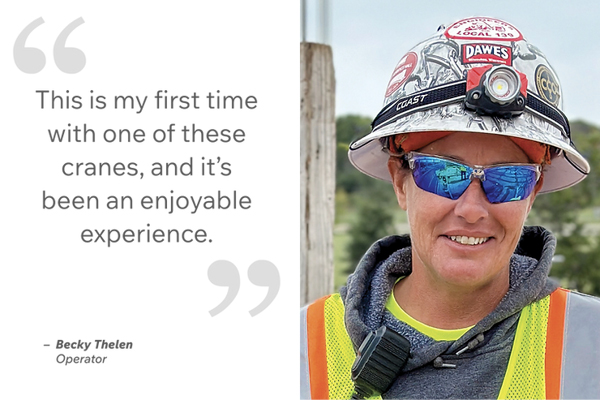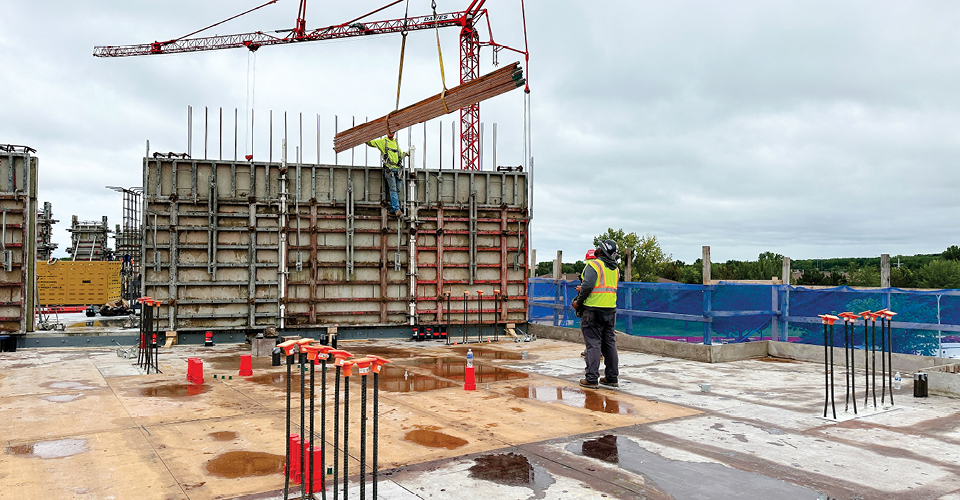Thank you for your interest in Potain self-erecting tower cranes.
Please fill out the form below and a crane expert will contact in 1-3 business days.
We use cookies on our website to give you the most relevant experience by remembering your preferences and repeat visits. By clicking “Accept”, you consent to the use of ALL the cookies. To learn more view our cookie policy.
Lift capacity and reach of two Potain Igo T 99 self-erecting cranes enable Immel Construction to efficiently build a college residence hall in Wisconsin.
University of Wisconsin-Green Bay (UWGB) has experienced a growing enrollment trend, requiring additional student housing. To support this growth, general contractor Immel Construction has overseen the construction of a 100,000 sq ft concrete residence hall in Green Bay since June 2023. The company is using two Potain Igo T 99 self-erecting tower cranes to complete the vertical concrete and carpentry work for the four-story building.
The project is underway in the middle of UWGB’s campus with limited space to maneuver equipment. The cranes have a 6-t lifting capacity and a 157 ft jib, enabling ample reach on the entire jobsite. Kaukauna-based Dawes Rigging & Crane Rental Sales Specialist Leroy Kane helped Immel Construction choose the right cranes for this project.

Immel Construction uses two Potain Igo T 99 self-erecting tower cranes to lift materials as it constructs a new residence hall at the University of Wisconsin-Green Bay.
“We look at a few different size cranes; ultimately, it came down to economics and the ability to move all of our parts and pieces without having to move around the job site,” said Immel Construction Superintendent Rob Van Donsel, who is overseeing the project. “When you are in tight areas, picking and lifting materials without stopping is a huge advantage for production and efficiency. That and the T 99’s lift capacity and reach made them the ideal cranes for our needs. They allow us to get to every inch of the site.”

Rob Van Donsel, Superintendent, Immel Construction.
Kane also helped Immel Construction set up the cranes, which took about a day. The cranes were placed on the same side of the building, and one was set up with a shorter jib to accommodate additional lifting capacity.
“You can set them up right next to the building and have a 360-degree reach to pick up materials, eliminating the need for a telehandler,” Kane said. “Capacity is another advantage because Immel Construction wanted to be able to handle sizable loads, and the Potain Igo T 99 cranes gave them that ability.”

Plus, the Potain Igo T 99 self-erecting tower cranes run on electric power, which lowers emissions and noise levels.
“We’re on a college campus with dorms right next to us, and we have had no complaints about noise, so these cranes are invaluable in this circumstance,” Van Donsel added.

The Potain Igo T 99 self-erecting crane’s small footprint works well on tight sites while still giving operators ample lift capacity and reach.
Operate anywhere with precision
Immel Construction operators David Chavanes and Becky Thelen lift rebar, structural components, such as forms, and various other items from the ground to the fourth floor of the building with the Potain Igo T 99 cranes via remote controls. The left joystick controls the trolley and swing, while the right joystick hoists up and down. A display on the remote control enables the operator to see wind speed, deflection, radius, and material weight.

Immel Construction utilizes two Potain Igo T 99 self-erecting tower cranes that each have a 6-t lifting capacity and a 157-ft reach for the structural building phase of a residence hall at the University of Wisconsin-Green Bay.
“Remote control allows us to position ourselves at the pick points where the load is and keep an eye on the entire process,” said Thelen, who has been a mobile crane operator for eight years and recently received certification to operate tower cranes. “I can always see the load and walk right to where I’m delivering it. I think it’s safer and more effective. This is my first time with one of these cranes, and it’s been an enjoyable experience. I would definitely recommend it in the right application.”

“We can operate from anywhere with precision,” added Chavanes, who has been operating cranes for a year. “Typically, whoever we are lifting for, whether it’s Immel or a subcontractor, will mark where the load needs to go, and I can put it exactly where it needs to be.”
Chavanes continued, “The panels are typically 10 to 15 ft wide. The heaviest load was about 3.8 t, so we experienced no issues with capacity. There haven’t been any issues with reach either, as we generally have only been out about 147 ft. They performed well. We have been running practically nonstop since they were erected in June.”

Operator David Chavanes uses a remote control to place materials with a Potain Igo T 99 self-erecting tower crane.
